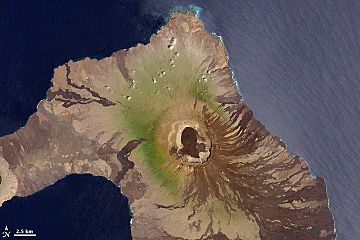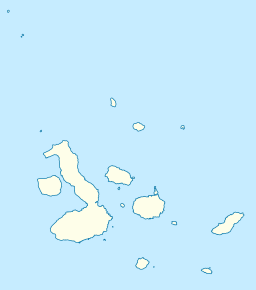Volcán Wolf facts for kids
Quick facts for kids Volcán Wolf |
|
|---|---|

Wolf Volcano, 2001, NASA Landsat 7 image
|
|
| Highest point | |
| Elevation | 1,710 m (5,610 ft) |
| Prominence | 1,710 m (5,610 ft) |
| Listing | Ultra |
| Geography | |
| Location | Isabela Island, Galápagos Islands |
| Geology | |
| Mountain type | Shield volcano |
| Last eruption | 7 January 2022 |
Wolf Volcano, also called Mount Whiton, is the tallest mountain in the amazing Galápagos Islands. It stands on Isabela Island and reaches a height of 1,710 meters (about 5,610 feet). It's a special type of volcano called a shield volcano, which looks a bit like an upside-down soup bowl.
This volcano got its name from Theodor Wolf. He was a German geologist who studied the Galápagos Islands a long time ago in the 1800s. There's also an island called Wolf Island in the northern Galápagos, which is named after him too!
Because Wolf Volcano is so tall, it's known as an ultra prominent peak. This means it rises very high above the land around it, more than 1,500 meters (about 4,921 feet).
Contents
How Wolf Volcano Formed
The Galápagos Islands, including Wolf Volcano, were created by something called a mantle plume. Imagine a hot spot deep inside the Earth that stays in one place. As the Nazca Plate (a huge piece of the Earth's crust) slowly moves over this hot spot, new volcanoes form. This movement is very slow, less than half a degree every million years!
Scientists think Wolf Volcano itself is less than half a million years old. But the ocean floor beneath it is much older, perhaps around 10 million years old.
Where Wolf Volcano Is
Wolf Volcano is located at the northern tip of Isabela Island in the Galápagos. It sits right on the equator! Isabela Island is made up of six volcanoes that have grown together. These include Wolf, Ecuador, Darwin, Alcedo, Sierra Negra, and Cerro Azul.
The volcanoes in the western Galápagos, like Wolf and the volcano on Fernandina Island, look different from those in the eastern part. Western volcanoes are taller and have bigger calderas (the large bowl-shaped hollows at the top). They also have that unique upside-down soup bowl shape.
Wolf Volcano is over 1,700 meters (about 5,577 feet) tall. Its caldera is huge, about 6 by 7 kilometers (3.7 by 4.3 miles) wide, and 700 meters (about 2,297 feet) deep. Only Cerro Azul has a caldera that's as deep in the Galápagos. After its last eruption, parts of the caldera collapsed, making it look like it has steps. Wolf has very steep sides, some as steep as 35 degrees, which makes it hard to climb.
The first time people recorded an eruption in the Galápagos was for Wolf Volcano in 1797. Since then, it has erupted eleven more times, with the most recent one happening in January 2022. Scientists can also study old lava flows to figure out when eruptions happened before 1797. The newest lava is found on the eastern and southern sides, and inside the caldera.
Amazing Wildlife
Just like other parts of the Galápagos, Wolf Volcano is home to unique animals. These animals are different not only from those on other islands but also from those on nearby volcanoes on Isabela Island!
Giant Tortoises
Wolf Volcano has its own special kind of Galapagos tortoise, called Chelonoidis nigra becki. These tortoises have a saddleback shell, which means the front of their shell is raised like a saddle. You can find them on the northern and western slopes of the volcano, where there's more plants and less recent lava.
Sadly, this tortoise is in danger. Wild cats sometimes hunt them, which reduces their numbers. In the past, ships used to drop off tortoises from other islands at Wolf Volcano, using them as a food source. In 2008, scientists found many different types of tortoises on Wolf Volcano, including some that looked like the famous Lonesome George. Scientists are now studying their DNA to learn more.
Pink Land Iguanas
In 2009, a brand new species of land iguana was found on the slopes of Wolf Volcano! It's called the pink land iguana. Park rangers first saw these pink iguanas in 1986, and scientists started studying them in 2000. They officially identified it as a separate species in 2009. Scientists are still trying to figure out how this pink iguana came to be, as they believe it separated from other Galápagos land iguanas even before Wolf Volcano or Isabela Island formed!
Protecting the Environment
The natural homes of the animals on Wolf Volcano are threatened by goats that were brought to the island. The Galápagos National Park has a project called Project Isabela. Its goal is to remove these wild goats from around Wolf Volcano to protect the native wildlife.
Recent Eruptions
2015 Eruption
After being quiet for 33 years, Wolf Volcano erupted on May 25, 2015. Luckily, the volcano is not near any towns or cities. The lava flowed down the east and southeast sides of the volcano. This meant the pink land iguanas, who live on the north and west sides, were safe!
2022 Eruption
On January 7, 2022, Ecuador's Geophysical Institute announced another eruption. Just before midnight on January 5, 2022, Wolf Volcano sent a cloud of ash and lava high into the sky, reaching about 3,793 meters (12,444 feet)!
See also
 In Spanish: Volcán Wolf para niños
In Spanish: Volcán Wolf para niños
- Volcanoes of the Galápagos Islands
- List of volcanoes in Ecuador
Images for kids



